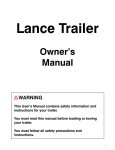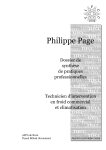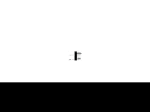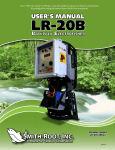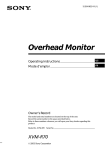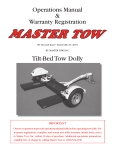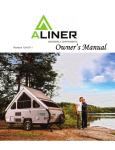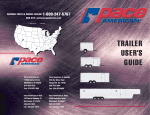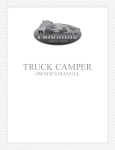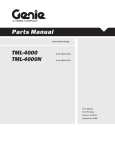Download Owner`s Manual - T@B Teardrop Trailers
Transcript
Owner’s Manual Welcome. Congratulations on your recent purchase of a Little Guy, Silver Shadow or T@B Teardrop Camper Trailer. The first teardrop trailers came about in the early 1930’s. Their popularity soared after World War II, fueled by returning vets restless to travel the country on a shoestring budget. Post-war builders often used materials from war surplus markets. The chassis were made from round steel tubing, wheels came from Jeeps that were salvaged from sunken ships and the exterior skins were usually fashioned from the wings of World War II bombers. While a lot has changed since the introduction of teardrop trailers on the American highway 8 decades ago, the styling, spirit and reasons for owning one remains the same. Ten years ago, Little Guy was founded with one goal in mind: to resurrect the ideal that ‘less is more.’ Remember the days when life was easier? Camping should be just that…because the journey is the destination. This manual was designed to acquaint and assist you with the operation and maintenance of your teardrop trailer. Following the instructions and recommendations in this manual will help assure the safe and enjoyable operation of your teardrop camper trailer. Your camper’s design is uncomplicated, built with the highest standards of integrity and truly reminiscent when times were simpler. That said, some parts of the manual will be more in depth (for the T@B) and not apply to Little Guys or Shadows. In the following pages, you will find general working knowledge of our trailers as well as some helpful hints to make your camping experience all that it should be. We are thrilled you have joined the family of the best-selling teardrops in the world and look forward to making sure you are a ‘happy camper.’ Table of Contents 1) Safety information 2) Chassis 3) Main Camper Assembly 4) Standard Electrical Features 5) Propane System 6) Water System 7) Preparing to Go 8) Arriving at Camp 9) Breaking Camp 10) Care and Cleaning 11) 7 Way Wiring Diagram 12) Warranty IMPORTANT SAFETY INSTRUCTIONS PLEASE READ AND FOLLOW ALL RELATED OPERATIONAL MANUALS AND THE INSTRUCTIONS IN THIS OWNER MANUAL BEFORE USE. THIS OWNER’S MANUAL IS INTENDED TO ACT AS A GENERAL GUIDE FOR OPERATION. THIS MANUAL IS SUBJECT TO CHANGE WITHOUT NOTICE AND MAY/MAY NOT INCLUDE INFORMATION REGARDING YOUR CAMPER. ALWAYS REFER TO THE SPECIFIC MANUFACTURER’S OWNER, OPERATIONS, AND SAFETY MANUAL FOR OPTIONAL EQUIPMENT WHICH INCLUDES, BUT IS NOT LIMITED TO, FURNACES, REFRIGERATORS, WATER HEATERS, COOKTOPS, AND DETECTORS. SAVE All INSTRUCTIONS. Reporting Safety Defects If you believe that your vehicle has a defect which could cause a crash or could cause injury or death, you should immediately inform the National Highway Traffic Safety Administration (NHTSA) in addition to notifying Pleasant Valley. If NHTSA receives similar complaints, it may open an investigation, and if it finds that a safety defect exists in a group of vehicles, it may order a recall and remedy campaign. However, NHTSA cannot become involved in individual problems between you, your dealer, or Little Guy/Pleasant Valley To contact NHTSA, you may call the Vehicle Safety Hotline tollfree at 1–888–327–4236 (TTY: 1–800–424–9153); go to http://www.safercar.gov; or write to: Administrator NHTSA 1200 New Jersey Ave SE Washington, DC 20590 You can also obtain other information about motor vehicle safety from http://www.safercar.gov Helpful Hints: • • • • • • • • • Make sure your trailer is properly connected to your vehicle prior to towing Never tow your trailer with the wheel jack exposed – remove it prior to travel Never tow your trailer without your safety chains attached securely Open your roof fan and/or windows for ventilation prior to sleeping Never carry any passengers in the trailer while it is in tow Ensure your doors, hatch, roof fan and windows are closed and locked prior to towing Make sure the stabilizer jacks are locked in the “up” position prior to towing Exercise caution when opening hatch (stored items may have shifted around) Secure any loose items in your cabin and galley to avoid damage Chassis MECHANICAL MAINTENANCE SHOULD ONLY BE PERFORMED BY A QUALIFIED MECHANIC. IF YOU DO NOT HAVE THE EXPERIENCE OR THE TOOLS TO SAFELY COMPLETE MAINTENANCE PROCEDURES, PLEASE CONTACT YOUR DEALER. WE ASSUME NO LIABILITY FOR INJURIES OR DAMAGES INCURRED AS A RESULT OF IRRESPONSIBLE, UNAUTHORIZED SERVICING. Tires/ Air Pressure Air pressure is the most important factor determining tire life and under inflation is the number one cause of trailer tire failure. Generic advice would be to maintain recommended air pressure listed on the tire sidewall, and periodically inspect both tires for tread wear and damage from road hazards. However, for a smoother, truer pull, we advise that your trailer tires be 35psi. All tires must be identical in size for the tires to properly manage the weight of the trailer. To properly maintain your tires, clean with mild soap and water. Do not use tire-care products containing alcohol or petroleum distillates and be sure to inspect the tires for any cuts, snags, bulges or punctures. Tire Sizes – all tires are 5 lug on 4.5” Rascal / 4x7 and 5x7 Joey / 4-Wide / 5-Wide / RT 175/80D13 1360# / 50 psi (we recommend not filling it to that level) 4x8 / 5x8 / 5x10 / 6x10 / 6-Wide / 6-Wide Sport / 6x10 RT / T@B 205/75D14 1760# / 50 psi (we recommend not filling it to that level) *Whitewall Tires – 1532#/35psi Rough Rider 235/65R15 1820# / 50 psi It is important to maintain proper wheel mounting torque on your lug nuts. When possible, use a torque wrench to prevent loose wheels and broken studs. Start all nuts by hand to prevent cross threading. Tighten the lug nuts in stages. First, tighten to 20-25 ft. /lb., then to 50-60 ft. /lb., and finally to 85-90 ft. /lb. Check lug nut torque before the first use. Check periodically thereafter. White and Black Rims use 13/16” lug nuts Black plastic caps over white rim lugs are removed by pulling straight off. Aluminum rims can use ¾” lug nuts, whether or not it is on the trailer or on the mount. How to Change a Flat First, get your trailer into a safe area where you have the space to work on it freely. Now, you are ready to begin: • Loosen the lugs • Drop the Nose of the trailer by cranking the wheel jack all the way DOWN • Flip out and Extend the Jacks as long as they can go • Crank the wheel jack all of the way UP • Remove the Lugs and the Tires – Replace with the spare • Repeat the above steps in reverse • Torque the lugs – YOU ARE READY TO GO! Axle **Follow all safety and specific operating instructions supplied by the Axle manufacturer.** All models use rubber torsion axles which offer greater dampening than conventional spring suspensions and allow each tire to move independently. This feature gives a smoother ride and improved tracking and cornering over rough road conditions. In addition, this type of axle has no metal to metal contact or springs, shackles, hangers, or U-bolts to wear out. Sizes Rascal / 4x7 Joey / 4-Wide / 4x8 1500# 5x7 Joey / 5-Wide / RT / 5x8 / 5x10 / 6-Wide 2000# 6-Wide Sport / 6x10 / 6x10 RT / Rough Rider (electric brakes) 2500# T@B – Hydraulic Surge brakes 3500# Electric Brakes The electric brake option (standard on the Rough Rider) on your camper is similar to the brakes on your towing vehicle, with the exception that the camper’s brakes are electromagnetic, while your towing vehicle’s brakes are hydraulic. Keep in mind that you must have a controller installed in your tow vehicle in order to enjoy the intended benefits of electric brakes. When the brakes in the towing vehicle are activated, your controller determines how hard they are being pressed, and sends the appropriate current through the hitch wire to the brake assembly. As you depress the brake pedal, the controller sends more current to the electromagnet, and the brake shoes press harder into the brake drums, forcing the wheel to resist rotation. Releasing the brake pedal decreases the current to the brake assembly, allowing the wheel to spin freely. The brakes are self-adjusting, but will need an initial manual adjustment after the first 200 miles. The brakes should be inspected every 3000 miles. Contact your dealer unless you have the tools and experience to do a brake inspection, adjustment, and replacement. Brake Adjustment (SEEK PROFESSIONAL ASSISTANCE): • Elevate the camper by positioning jacks under the frame 12” to 20” behind the axle. Use the jack stands under the frame to support the camper any time it is elevated. • NEVER PLACE THE JACKS UNDER THE FLOOR OR USE THE STABILIZERS TO ELEVATE THE CAMPER. • Do not remove the wheels or hub/drum assembly. • Locate the adjusting slot at the bottom of the backing plate and remove the protective cover. • While spinning the wheel, use a blade screwdriver to rotate the star wheel until there is a heavy brake drag. • Loosen until the wheel turns freely. • Replace the protective plug. • Repeat adjustment steps for the other wheel. • Never adjust just one brake. Brake Inspection: The brake linings and magnets are subject to wear and require inspection every 6,000 miles or annually. Replacement is necessary if the linings are worn (to within 1/16” or less), contaminated with grease or oil, or abnormally scored or gouged. It is important to replace all linings (both wheels) at the same time to maintain even braking action across the axle. Annually inspect the wires under the trailer and on the axle for broken insulation or faulty connections. Repair or replace as necessary. Bearing Inspection: Wash all grease and oil from the bearing and cone using a suitable solvent. Dry the bearing with a clean, lint free cloth and completely inspect each roller. Replace the bearing cone and cup if there are any signs of pitting, wear, or corrosion. Repeat the inspection procedure for the inner bearing cone. ALWAYS REPLACE THE BEARING CONE AND CUP AS A PAIR. **IMPORTANT** DO NOT MIX LITHIUM, CALCIUM, SODIUM, OR BARIUM COMPLEX GREASES DUE TO POTENTIAL COMPATIBILITY PROBLEMS. WHEN CHANGING FROM ONE TYPE OF GREASE TO ANOTHER, IT IS NECESSARY TO INSURE THAT ALL OF THE OLD GREASE HAS BEEN REMOVED. Bearing Lubrication: Proper adjustment and adequate lubrication of the bearings are essential to the longevity and performance of your trailer axle. The bearings should be lubricated every 6000 miles or 6 months. Procedure: • Remove the rubber plug from grease cap. • Insert grease gun on the grease zerk. • Pump until new grease begins to appear. • Replace rubber plug. Frame The new main frame members are 2.0” x 3.0” 11 gauge C-Channel steel. The old tubular frame members were either 2.0” (Rascal, Joey, 4x8, 5x8, 5x10) or 3.0” (4-Wide, 5-Wide, 6-Wide, Sport, 6x10, RT, 6x10 RT) 12 gauge box channel steel. The Rough Rider has an additional 12 gauge box channel steel frame with skid plates supporting the main frame. The T@B has the larger 2.0” x 6.0” 11 gauge C-Channel Steel. All C-Channel frames have been E-Coated; whereas, all others have been powder coated to produce a high specification coating which is relatively harder and more abrasion resistant. No normal maintenance is required, but if the welds or scratches need attention, first remove any rust, dirt, or grease and coat with gloss black touch up paint. There is a receiver located on the rear bumper (except for Rascal, Joey and RT) for optional equipment. This receiver is designed for light weight cargo with the load positioned close to the receiver and bumper. DO NOT EXCEED 125 POUNDS total weight on the receiver. Coupler Your coupler needs no adjusting or maintenance other than periodic oiling to ensure smooth operation. All models use a coupler that receives a 2” ball. Set the hitch height of the tow vehicle so that the trailer is being pulled in a horizontal position. The height listed below is the optimal height after the tongue weight is resting on the hitch. Trailers must be towed as level as possible for proper handling and weight distribution. All Little Guy, RT and Silver Shadow Trailers Set ball height at 16” from ground to top of ball. T@B Set ball height at 16” from ground to top of ball Attaching the Trailer to the Tow Vehicle Position the receiver over the ball, and lift the tab handle of the hitch upward as you lower the jack. After the ball is seated, allow the handle to return back down parallel to the frame. It will click, indicating that it has locked onto the ball. Attach the safety chains, insert the camper plug into the towing vehicle receptacle, and test the signal lighting. Raise the jack as far as it will go by turning the crank handle clockwise. Remove the castor wheel by removing locking pin and sliding the wheel assembly downward. The locking pin can be inserted into the hitch locking mechanism for storage and added security. **The Rascal does not have a wheel jack, but rather a spring loaded, flip down tongue jack. ** Do not tow the vehicle with the front jack in the lowered position. Stabilizers All trailers are equipped with lightweight stabilizer jacks. The T@B, Rough Rider and 6x10, are beefier and include a ¾” speed crank handle for quick response of both the up and down movement. The high strength design allows for increased load stabilization and fine leveling. ** All Little Guy and Silver Shadows have two rear stabilizers only. Oil the jacks periodically to ensure smooth operation. Never use the stabilizers to raise the camper tires off the ground – unless changing a flat. Always raise the stabilizers completely before travel. Main Camper Assembly Floor One solid piece of vinyl flooring covers the Little Guy or Silver Shadow’s wooden floor. The T@B’s floor is an aluminum framed piece that has shot block foam insulation that is backed by wood. On each, the underside is covered with an all-weather, moisture resistant material. This, along with proper caulking and installation, will keep your camper free from rot or corrosion. Sidewalls The sidewalls on a Little Guy or Silver Shadow are constructed with a multi-layered approach. The exterior is a ¼” sheet of azdel (a plastic, non-moisture absorbing wood) with laminated fiberglass exterior. This sheet is sandwiched with a 5/8” of Eucalyptus with carpeting on the wall (Little Guy) or Birch with finished interior wall (Silver Shadow). The sidewalls on a T@B are a 1 ¼” aluminum framed, shot block foam insulation. The exterior is a laminated fiberglass while the interior is a Berkshire vinyl. Roof The external material on the roof of your camper is aluminum. It is .040 uber-durable, painted aluminum, as are the hatch doors. Extrusions All of the aluminum extrusions on the camper are powder coated to resist weathering. This paint process creates a protective film to ensure aesthetic and functional permanence. Seals All models contain varying sizes and shapes of both rubber and foam seals. These seals should be inspected regularly for tears, rips, or deterioration. If seals need replaced, please contact our parts and warranty department. Insulation All of our campers are insulated to a high degree. The T@B trailers are fully insulated (roof, walls, door and floor). The entire trailer is shot-block foam except for the roof, which is cut insulation. The Little Guy and Silver Shadow Trailers are likewise insulated with cut insulation from the front of the trailer throughout the roof to the back hatch door. The side doors and hatch doors are insulated with shot block foam. The sidewalls and floor of the camper are not insulated, but do have an R-Value. In all, the R-Value of the insulation components that are employed is R-12. You should be able to comfortably camp without any type of heating device into the 40’s. The compact nature of your camper allows for body heat to be the primary source of heat. In a Little Guy or Shadow, you could employ an electric blanket or small 12v ceramic heater. The T@B offers a furnace as well as an optional heat pump, if you purchased the Coolcat. Lights There are two separate lighting systems in your camper. The 12 volt convenience lights require power from the converter, battery, or the battery of the towing vehicle. If your trailer does not have 12 volt power, 2 AAA battery operated lights will be installed in the cabin and 1 in the galley. The trailer signal lights receive power from the towing vehicle’s brakes, turn signals, running lights, and reverse lights. You should test the trailer and towing vehicle lighting systems before every outing. Fan-tastic Vent Each model with 12 volt features a fan to evacuate the hot air that collects inside the roof peak. Best results can be achieved by closing all other roof vents and opening a window on the shaded side of the camper. The roof vent must be open approximately 3” before the motor will operate. Always lower and lock the vent in the down position before travel. Standard Electrical Features Converter **Follow all safety and specific operating instructions supplied by Converter manufacturer. ** The converter changes standard household electrical power into 12 volt dc, the type of electrical power necessary for the operation of RV appliances and recharging RV batteries. There are three modes of operation that the converter automatically senses and then self-adjusts. When connected to shore power, the converter will charge and supply power to appliances. When connected to your vehicle, it supplies a slight trickle charge to maintain battery charge during storage. Please follow converter manual for operation and safety instructions. Do not block the small, automatic cooling fan on the converter. Auxiliary Battery TO AVOID CONVERTER DAMAGE DO NOT REVERSE THE BATTERY POLARITY! Caution: Wet RV Batteries contain sulfuric acid. Handle with care. An auxiliary battery enables you to operate 12-volt dc appliances without draining your tow vehicle battery or plugging your converter into a 120volt AC receptacle. Lights, heater fans, water pumps, roof fans, radios, and cigarette lighter receptacles can run on the auxiliary battery power. Air conditioners, microwave ovens, and standard outlets operate exclusively on 120 volts AC and therefore cannot run from auxiliary battery power. T@B and Rough Riders use a deep cycle battery because its design gives maximum performance between recharging without damaging the battery. Note: A deep cycle battery will take longer to recharge as compared to a regular automotive battery. All other models employ an on-board, dry cell battery. Secure the lug and wire that has the 20-amp in line fuse to the batteries positive terminal. The lugs on the remaining two white wires connect to the batteries negative terminal. ** Do not reverse the polarity of the battery and 12 volt wires as damage can occur to the converter and wiring system ** If there is an electrical problem, first check the 20-amp fuse at the battery then check the fuses located in the converter. Do not replace battery fuses with anything other than a 20-amp fuse. Some models are equipped with an internal storage box for the battery. This dual vented battery box is required to discharge the hydrogen gas produced during charging. In cold weather, store the battery in a location where the temperature remains above freezing. Do not charge or store your battery in the camper unless it is in its proper enclosure. 120 Volt AC Amp Ratings Appliance or Electronic Equipment • Air Conditioner • Blender • Coffee Maker • Compact Disc Player • Computer (Laptop) • Converter • Crock Pot • Curling Iron • Drill • Electric Blanket • Electric Fan • Electric Water Heater • Electric Skillet • Hair Dryer • Iron • Light (60 watt % 120V) • Microwave • Microwave (Convection Oven) • Refrigerator in AC mode • Space Heater • Television • Toaster • Vacuum (handheld) • VCR • Washer/Dryer Estimated Amps 12-16 Amps 5-6 Amps 5-8 Amps 1 Amp 2-3 Amps 1-8 Amps 1-2 Amps <1 Amp 2-6 Amps 0.5-1.5 Amps 1 Amp 9-13 Amps 6-12 Amps 5-12 Amps 5-10 Amps <1 Amp 8-13 Amps 13 Amps 5-8 Amps 8-13 Amps 1.5-4 Amps 7-10 Amps 2-6 Amps 1-2 Amps 14-16Amps 12 Volt DC Amp Ratings Appliance or Accessory • Aisle Light • CO Detector • LED Lights Estimated Amps 1 Amp 1 Amp <1 Amps • • • • • • • • • • • • • • • Furnace LP Gas Leak Detector Overhead lights (Per Bulb) Porch Light Power Roof Vent Radio/Stereo Range Hood (Fan & Light) Refrigerator (LP Gas Mode) Security System Television (12 volt) TV Antenna Booster TV Antenna Booster 12 Volt outlet Variable Speed Ceiling / Vent Fan VCR Recorder / Player Water Pump 10-12 Amps 1 Amp 1 Amp 1 Amp 1.5 Amps 4 Amps 2-3 Amps 1.5- 2 Amps 1 Amp 4-5 Amps <1 Amp Up to 8 Amps 4 Amps 2 Amps 4 Amp Wattage % Volts = Amps ; Amps X Volts = Wattage Ground Fault Circuit Interrupt (GFCI) In accordance with RVIA standards as well as the NEC, your camper is equipped with a ground fault circuit interrupt (GFCI). The GFCI receptacle is a safety device designed to protect against shock hazards. Test the GFCI monthly by pressing the test button on the outlet. After testing, press the reset button to restore power to the receptacle and the branch circuits. If you lose power to your outlets, check the GFCI to see if it needs reset. If the GFCI will not reset, check to see if a breaker on the converter or campground supply has tripped. LP (Liquid Petroleum) System ** NOTE** THE FURNACE, REFRIGERATOR, STOVE, AND WATER HEATER BURN LP (LIQUEFIED PETROLEUM) GAS DURING OPERATION. LP GAS IS A VERY RELIABLE, CONVENIENT, AND AFFORDABLE FUEL. HOWEVER, THIS GAS IS EXTREMELY DANGEROUS WHEN SAFETY PRECAUTIONS ARE IGNORED. LP Gas Tanks To remove the tanks (or bottles) for filling, turn the tank valves off. Disconnect the hose or fitting to the tank valve. Loosen the wing nut on the mounting bracket. To transport or store the tank, install the plastic plug into the valve body. This prevents dust, dirt, and moisture from collecting in the valve. This plug also protects the threads. After filling the tanks, fasten them securely to the mounting bracket using the wing nuts. Checking for Leaks A hissing sound, condensation, or LP odor may indicate a ruptured gas line, in which case you should turn the tank valve off immediately and have the system service by an authorized service center. Before checking for leaks, make sure all LP gas appliances are turned off. Put out all flames and sources of sparks. Turn the tank valve on and generously apply a mild soap and water solution to each connection. Bubbles will appear if there is a leak. If it leaks at a fitting, simply tightening the fitting may stop the leak. Caution: Do not over tighten the fitting as they may crack. If the leak continues even after tightening, replace the fittings. Leaks around the seals or vents of the regulator will require replacing the regulator. After testing for leaks, purge the air in the gas lines by opening a valve until you detect the odor of LP gas. Allow enough time for the gas to dissipate before lighting any appliances. Periodically inspect the tanks for dents, cracks, and corrosion. Inspect the mounting hardware and hoses for signs of wear, and replace if necessary. Always keep the valve on the tank closed when not in use or when traveling. Never fill a tank over 80%. Never test for leaks with a flame, or use products containing ammonia or chlorine to test for leaks. Do not store your tank in an enclosed place with extreme temperature changes. If necessary, you may repaint your tank. LP Detector ** Follow all safety and specific operating instructions supplied by Detector manufacturer. ** LP gas is heavier than air so your detector is mounted near floor level. This device runs continuously from the 12 volt source. Current consumption is low (typically 10 mA), and will not drain your battery during normal use. However, if the camper is not going to be used for long periods, you can temporarily remove the in line fuse located near the battery to avoid unnecessarily draining. ** BE SURE TO REPLACE THE FUSE BEFORE USING THE CAMPER. ** Stove ** Follow all safety and specific operating instructions supplied by Stove manufacturer. ** ** NEVER OPERATE THE STOVE FOR COMFORT HEATING! BEFORE LIGHTING THE STOVE, OPEN A WINDOW AND A ROOF VENT. “ Failure to observe these rules may result in potentially dangerous levels of carbon monoxide inside the camper if your camper has been equipped with a built in counter cook top or a two burner indoor/outdoor cook top. Atwood manual lighting instructions: • Make sure LP gas is on at the shutoff valve. • Press burner control inwards and turn counter-clockwise. • Immediately light the burner by holding a match or hand held spark igniter near the burner ports. • Extinguishing instructions: Turn the appropriate burner knob clockwise to off. SMEV lighting instructions: • Make sure LP gas is on at the shutoff valve. • Press in knob and turn to “ignite” position. • Keep the knob pressed in and push the ignition button. • Once the burner has remained lit, turn the knob to the desired flame. • Extinguishing instructions: • Turn the appropriate burner knob clockwise to off. Indoor / Outdoor Stove instructions: ** Follow all safety and specific operating instructions supplied by stove manufacturer. ** For units equipped with the indoor/outdoor stove or grill: ** Do not operate indoor / outdoor stove or grill with optional awning erect. ** An extruded aluminum bracket, which holds the cook top or grill, is mounted on the rear door side of the camper. Tilt the front of the grill up as you attach the rear pin into this bracket. Lower the grill down slowly until the bracket supports the weight. The flexible propane hose is then attached to a quick connect adapter located under the camper directly below the grill. The quick connect has a security feature which will only allow the disconnection of the hose if the valve lever is turned perpendicular to the hose. This would place the valve in the off position. When used inside the camper, follow all instructions for operating cook top indoors. The quick connect is located under the front driver side bunk or in some models under the sink area. The quick connect has a security feature which will only allow the disconnection of the hose if the valve lever is turned perpendicular to the hose. This would place the valve in the off position. 110 Water Heater ** Follow all safety and specific operating instructions supplied by Water Heater manufacturer. ** Do not plug in until you fill the tank with water. Plugging in, without filling with water, will burn out the element. Caution: Water heater is capable of heating water that can cause serious burns. The thermostat is not adjustable and is set to maintain water temperature of 135 degrees. Water temperatures over 125 degrees can cause serious burns. Furnace ** Follow all safety and specific operating instructions supplied by Furnace manufacturer. ** The 11,000 BTU electronic ignition furnace operates on LP gas for its fuel source but also needs 12 volt electric to operate the blower. Do not attempt to light by hand! Atwood • Operating Procedure: o o o o Open the valve on the LP tank. Move small switch located on the thermostat to the “on” position. Set thermostat to desired setting. To shut off: Slide thermostat to lowest setting. Move switch located on thermostat to the “off” position. Close the LP valve on the tank when not in use. Water System The water system is operated by two different methods. The first method of use is done by hooking a potable water hose directly to the city water port on the outside of the camper. The lockable access door is located outside on the driver rear side of the camper. The city water port has a screen to keep debris from entering the interior lines. The screen and washer can be removed for cleaning. After connecting the water hose and turning the water on, the lines and hot water tank will fill. Slowly open the sink faucet to allow air to escape from the lines. The onboard pump does not need to be turned on if using this water system method. The second method of operation is using the fresh water holding tank. The water tank is filled using the fresh water access port located to the right of the city water port. Insert a hose into the port and fill the 11 gallon tank. When full, turn on the water pump using the switch located on the master appliance control panel. This will operate the 12 volt demand pump and push water into the lines and also the hot water tank. The pump will shut off after 45 PSI pressure is reached and run again if the pressure drops. Slowly open the sink faucet to allow air to escape from the lines. The DSI Hot water tank will hold 6 gallons of water, so the fresh water tank will need to be refilled afterwards. The sink faucet and outside shower will operate on either water system. Do not operate the demand pump without water. The gray water from the sink runs directly to the drain valve located on the driver side by the wheel well. The 1 ½ “drain cap can be unscrewed by hand for allowing the gray water to drain into a bucket. A hose adapter can be added to the drain if required by the campground. Be sure to re-secure the drain cap before travel. Water Heater See the LP (Liquid Petroleum) System Water System Maintenance * Sanitize the water system before the first use, as well as before and after storage. * Winterize all water system components before exposure to freezing temperatures. Failure to follow proper winterizing procedures can result in cracked pumps, faucets, and other plumbing hardware problems which will not be covered under the warranty policy. After the camping season and before the first freeze of the winter, it is important that you winterize. All water should be drained from the fresh water and hot water tanks, the water lines, outside shower, and drains. To winterize the water system: Open the petcock under the floor below the water tank and allow all water to drain out. Open the ¾“screw-off cap located under the camper and allow water to drain form the lines and hot water tank. This water drain is placed at the lowest point in the system. Elevating the front of the camper, opening the sink and shower faucets, and opening the pressure relief valve on the hot water system will assist in draining. Remove the anode rod from the hot water tank and replace it with a ¾ inch drain plug. Open the 1 ½ gray water drain cap and allow remaining water to drain. After all water is drained, the lines can be either be blown out using compressed air or refilled with special nontoxic RV antifreeze available from your dealer. Add roughly two gallons of RV antifreeze to the potable water tank and use the water pump to pump the antifreeze through all of the water connections. Let at least a cup of antifreeze go down each drain to protect the traps. Finally drain any remaining antifreeze from the tank and be sure that the water heater is drained and left open. In the spring, after the last frost, you must drain all the antifreeze from the system and sanitize the entire water system. Fill the tank full of water and run the pump to pump fresh water through the entire system including the water heater. After all the antifreeze has been cleared out, use household bleach to sanitize the system. All potable water systems (water suitable for drinking) should be sanitized before and after storage. Also, sanitize water systems with new equipment, or systems that have been subjected to contamination. Sanitizing disinfects the water system and helps to provide safe, clean water. Multiply the potable water tank gallon capacity by .13 for a four hour treatment, or by .26 for a one hour treatment. This will give the liquid ounces of common household bleach required for disinfecting the water system. Add the proper amount of bleach to a container with water and mix. Pour the solution into the water tank and fill the tank with potable water. Turn on the electric pump and open all faucets including showers. Shut off the faucets when you smell chlorine. Allow the proper treatment time (as determined in step 1) before draining the tank and refilling with potable water. The sanitizing procedure outlined above is in conformance with the approved procedures of RVIA ANSI A119.2 and the U.S. Public Health Service. Preparing to Go Our trailers have been designed for use in virtually all environments; however some conditions may require extra caution or care to prevent damaging your camper. Some owners use their campers in cold temperatures. The trailer build is suited for this type of use, however the extreme temperature differences from inside and outside the camper can cause condensation, particularly on aluminum. This moisture can freeze between the seals and the extrusions and thus damage the seals if the camper walls or roof is lowered while still frozen. We recommend that if using your camper under these conditions, you should spray the weather-stripping and extrusions with silicone spray or Rain X. These products will help prevent the seals from freezing to the extrusions. To eradicate condensation, increase air flow by cracking the vent or windows to increase ventilation. Balance the load. Loading improperly can adversely affect handling while towing. Try to distribute your camping gear so the hitch weight is 10-20 % of the gross vehicle weight. (TOTAL WEIGHT OF THE LOADED CAMPER) Ideally, whenever possible the heaviest objects should be stored near the axle, directly over the frame members. Arriving at Camp Position your camper so it is level front to back and side to side. If adjustment is necessary, use leveling boards under the wheels and raise or lower the tongue jack. Lower the front and rear stabilizers. Do not use the front and rear stabilizers to level the camper. The stabilizers should be lowered into position after the camper is leveled. The pads of the stabilizers should be firmly on the ground, but not to the point of raising the camper. Position wheel chocking if needed. Lower the step (if needed). Mattress No matter the model, your camper comes furnished with a 4” thick urethane foamed mattress. In the Little Guy, it is a tri-fold unit ranging in size from 46” x 69” to as a large as 70” x 76.” The Silver Shadow mattress is a split mattress that when laid side by side has dimensions ranging from 46” x 75” to as large as 70” x 79.” The T@B “mattress” is made from several cushions that when laid out will be 70” x 58” in the L or Clamshell, where as it is 70” x 73” in the U, Q or S (if no AC unit is chosen). Connect Utilities Fill fresh water holding tank by inserting a clean hose into the large capped opening at the water fill compartment, located on the driver side of the camper. Connect hose to city water connection at same water fill location. Slowly open sink faucet to bleed out any air in the lines. If only using fresh water holding tank and not city water, the pump switch located on the counter (in a Little Guy or Shadow) or kitchen wall (in a T@B) must be turned on. Do not operate the pump unless there are at least 1 ½ inches of water in the potable water holding tank. The pump is not necessary and should not be turned on if using the city water connection. Access the electrical shore power cord on the driver’s side of the camper and plug into the campground’s 30 amp outlet. An adapter can be used to plug directly into a standard household 15 or 20 amp outlet. For the T@B, turn on propane using the valves on the LP tank(s) located on the front of the camper. If you have a hot water heater in your T@B, fill it with water prior to plugging it in. Failure to do so, will burn out the heating element. Many T@Bs are equipped with a gray water holding tank. All other T@B, Little Guy and Shadow sinks are plumbed to drain directly to the outside. The cap for this drain is located on the driver underside of the camper. If the campground requires a hose drain, you must provide a container for the fall off water. There is a 75 ohm coaxial TV connector located on the outer driver side which will fit standard cable connectors. Toilet/Shower Operation: Please Consult Specific User’s Manuals. Before Leaving Disconnect all campground utilities. Raise all the stabilizers. Raise the step(s). Attach to tow vehicle hitch and lock into position. Attach safety chains. Attach 12 volt pigtail cord to tow vehicle. Raise the front jack completely. Remove the front castor wheel. Remove wheel chocking. Care and Cleaning The exterior of the camper can be cleaned with mild soap and water. Do not pressure wash. The windows and vents should be cleaned with mild soap and water. Use only a cleaning agent safe for polycarbonates. A soft lined cover can be used to shield the camper when in storage. Additional protection, such as a soft towel should be used to protect the skylights from abrasions. The Do’s and Don’ts of cleaning applied vinyl vehicle graphics The Do’s • Wash applied vinyl graphics with a blend of mild car wash detergent and clean water. • Test any cleaning solution on a small section of the vinyl graphic before using. • Always read the warning labels on car care products for proper safety instructions. • Once you’ve washed the vehicle with a soapy water blend, rinse with clean water. Let the vehicle air dry or dry off with a microfiber cloth. The Don’ts • Do not allow fuels to stay in contact with the vinyl for extended periods of time. Clean all spills as soon as possible. • Do not apply carnauba-based wax over vinyl graphics. • Do not use mechanical brush washing. Brushes can cause vinyl graphics to chip or peel around the edges or scratch the surface. They can also cause the graphic to fade, and dull the appearance of the over laminate. Concerns about pressure washing vinyl vehicle graphics Pressure washing should only be used when all other cleaning methods have been exhausted. Keep the following in mind while performing this type of cleaning… • Pressure washing can cause the vinyl graphics to lift around the edges and peel away from the vehicle. (For Example See Diagram 1b.) • Over time, pressure washing can degrade the face film causing the graphic to lose its luster, fade, crack and even chip away from the substrate. Please consider the following to help prolong the life of the applied vehicle graphic when choosing to pressure wash. (Based on vertical application) • Water Temperature…72°F+/- 5°F ; Spray nozzle opening…40° wide pattern ; Spray angle…45° ; Angle of graphic…90° (vertical) • Distance from graphic…15” ; Water pressure…<= 800 PSI ; Length of time…30 sec. Use extreme care when aiming the water spray toward the edge of the vinyl graphic. Sharp spray angles can cause vinyl graphic to lift from vehicle. Absolutely under no circumstances should a turbo pressure nozzle be used when pressure washing applied vehicle graphics. How to remove difficult pollutants or debris from applied vehicle graphics When normal cleaning procedures don’t work to remove difficult debris from your applied vehicle graphics, try the following. • Spot clean the area with Isopropyl Alcohol and a microfiber rag. Moisten a rag with a citrus based cleaner and naphtha and wipe down the problem areas. If these cleaning methods do not work on problem areas please contact Oracal Product Technical Support for more helpful tips and information. How to properly hand wash vinyl vehicle graphics. Supplies Needed: • Garden hose with standard spray nozzle attachment, Clean bucket, Mild car wash detergent, Soft cotton or microfiber sponge, Dry microfiber clothes 1. Rinse the graphic with water to wash away any loose sediments, dust, or dirt using your garden hose with spray nozzle attachment. 2. Mix together water and mild car wash detergent into your bucket. (Make sure the bucket is free of dirt and small rocks as these will scratch your car and or vinyl graphics.) 3. Soak your sponge with the water and soap mixture. 4. Clean the graphic starting from the top working down to the bottom. This will allow the dirty contaminated water to run downward. 5. Rinse the graphic with clean water using the hose with spray nozzle attachment. 6. Once the graphic is rinsed off with water allow it to air dry. You may also use a microfiber cloth to dry down the graphic. 7. Once dry, for added protection, you may apply a silicone or Teflon based polish designed for vinyl vehicle graphics. (Read and follow product manufactures directions and suggestions for frequency.) General Information This information is based on our knowledge and experience. We have not explained all aspects of application. Specialized or occupational knowledge and competence of a professional sign maker are presupposed. Due to the diversity of potential influencing factors during application and use, we recommend customers make their own tests of our when the films will be used for special applications. No legally binding warranty of certain qualities can be derived from our information. Oracal USA, INC 1100 Oracal Parkway, Black Creek, GA 31309. Common Issues & Trouble Shooting Contact: Ed Kauffman Parts & Warranty Department [email protected] 330.852.4820 Problem Cause Solution_____________ Interior Lights/fan/ 12 outlet not working No 12v power Check fuses ; check battery Running Lights not working Loose Connection Check visible connections; Call Tail lights dim or bulbs not lighting Lights burning out Call 330.852.4820 to obtain replacement Converter not functioning Blown Fuse/Tripped Breaker/Bad part Check/Replace fuses ; Call Air Conditioning not functioning Lack of Ventilation ; Bad part Call 330.852.4820 Furnace not lighting LP Valve closed; 12v fused out; bad control Open LP Valve, Check Fuse, Call Water Heater not Heating Not Plugged into shore line; bad element Connect to 120v ; Replace element ; Call Water Pump (no water) Pump not activating ; loose fittings Check Fuses ; Check Fittings ; Call DVD Player not Functioning no power ; bad component Check fuses/shoreline ; read manual; Call Coupler Lock Won’t Latch nut too tight/too loose Tighten nut How Can I remove my graphics Ugly or aged graphics Hair dryer to remove; order new 877.545.4897 Not enough privacy/shade No window shades Order Window Shades - 877.545.4897 Not enough living space Confined to trailer Order Custom Screen Room/Tent - 877.545.4897 NEW TRAILER LIMITED WARRANTY Pleasant Valley Teardrop Trailers will make repairs to defects in workmanship or materials, free of charge for one year from the retail purchase date. Because of design changes and improvements, we reserve the right to substitute parts, materials or components with ones of equal value and quality. This warranty applies only to the original retail purchaser of a new product from an authorized Little Guy or T@B Dealer. The owner is responsible to maintain the camper in accordance with the instructions provided in the owner’s manual. Failure to follow proper procedures and seasonal maintenance schedules may void your warranty. Warranty Services: To obtain warranty services, contact the factory and ask for Warranty Department. If your warranty is not registered, you will be asked to provide a sales receipt to document the date and location of purchase. Warranty Coverage: We make every effort to assure that its products meet high quality and durability standards and warrants to the original purchaser that this product is free from defects in materials and workmanship for a period of one (1) year form the date of purchase. As the manufacturer of your Little Guy, Silver Shadow or T@B teardrop trailer, Pleasant Valley will make or provide for repairs to be made for defects in workmanship or materials, free of charge for a period of one year from the retail date of purchase. We do not include warranty coverage on some components, as the vendor prefers to service those directly. Due to design changes and improvements, we reserve the right to substitute parts, materials or components with ones of equal value and quality. The warranty is non-transferable. The owner is responsible to maintain the camper in accordance with the instructions provided in the Owner’s manual. Failure to do so, may void your warranty. Notification: To obtain warranty services, contact Pleasant Valley Teardrop Trailers at 330-852-4820 or if you do not hear within 48 hrs, please call 330-852-4811. If you have not registered your warranty registrations, you will be asked to provide your bill of sale, so that the purchase date can be verified. Warranty Claim Procedure: Upon discovery of a defect, please contact Pleasant Valley Teardrop Trailers within 5 business days by registered letter or phone call. Do not contact Little Guy Worldwide – you may consult with the dealer from which you purchased the trailer, Please be prepared to provide the VIN number of the trailer along with your name and best mode of contact (along with hours, if necessary). Excluded From Coverage: • Equipment or parts with separate, standalone warranties (axles, fans, tires, converters and any appliances). o Fantastic Vent (vents and fans) - 800-521-0298 or [email protected] o ASA Electronics (Audiovox Flipdown TV and T@B Entertainment Center) - 877-305-0445 or [email protected] o AL-KO (axle) – 574-294-6651 or http://www.al-kousa.com/contact.htm o Dexter (axle) - (574) 295-7888 o Tredit Tire (Tires and Wheels) – 800-537-2925 or [email protected] o Harris Battery (Battery) – 800-367-7670 or [email protected] o Atwood (Stove) – 800-546-8759 or www.atwoodmobile.com/contact-us.asp o Hehr International (Windows) 574-935-5122 ask for Donna o Cheng USA (WFCO Converter) - 877-294-8997 or [email protected] • Misuse, Abuse, Collision, improper repairs, overloading, neglect or lack of maintenance which results in damage. • Alteration or installation of equipment, not approved by Pleasant Valley Teardrop Trailers LLC, that results in damage – this includes, but is not limited to electrical, gas, plumbing or structural issues. • Normal wear, fading or deterioration of fabrics, flooring, graphics or metal components – including weathering, discoloration, surface corrosion of unpainted surfaces or minor blemishes due to normal use. • Any product used outside of the intended scope of its customary purpose. • Any unregistered product not normally used in the US or Canada. • Any product used as a rental unit. • Any promises made by any person beyond what is stated in this document • Condensation on any window or other parts or any results of condensation. Any service charges, towing charges or transportation costs are the responsibility of the purchaser/owner. This warranty is void if the product has been misused in any way. This includes overloading, improper load distribution, lack of preventative maintenance, unauthorized repairs, alterations abuse or any other use for which the trailer was designed. As such, neither Pleasant Valley Teardrop Trailers nor Little Guy Worldwide shall not be liable for incidental or consequential damages, such as expenses for transportation, lodging, damage to personal property, loss of personal property, loss of use of product, inconvenience or loss of income. Some states do not allow the exclusion or limitation of incidental or consequential damages, so the above limitation my not apply specifically to you. Legal Procedures: In addition to the provisions of this warranty, the retail purchaser has available the legal remedies provided by the Magnuson-Moss Warranty Act and any applicable State statutes. Implied warranties, including any warranty of merchantability or fitness of a product for a particular purpose, are limited in duration to the term of this written warranty. Some states do not allow limitation on how long such a warranty lasts, so the above limitation may not apply. You may have rights, outside of what this warranty states, which is on a state by state basis. We want you to be completely satisfied with your new camper. For further information or help, please contact the factory Pleasant Valley Teardrop Trailers LLC, 754 Edelweiss Dr NE {P.O. Box 395}, Sugarcreek, OH 44681 * Parts/Warranty Direct Line: 330-852-4820. Main Office Line: 330-852.4811 Fax Line: 330-852-7065 WARRANTY CLAIM PROCEDURE If you have an issue, please call Ed Kauffman at Pleasant Valley Teardrop Trailers at 330-852-4811 to troubleshoot. In the event a warranty claim needs to be submitted, please complete the following steps: Step 1: Write Down the VIN number __________________________________________ In the event your trailer’s VIN does not start with 1P9, you may still receive troubleshooting/assistance and/or parts for repair. Step 2: Provide Owner’s Information and repair center’s information, if applicable. Name __________________________________________________________ Phone ___________________________ Email ______________________________________ Address ____________________________________City ____________________________ State _______ Date of Purchase ___________________________ RV Repair Center ________________________________________________________ Phone ___________________________ Email ________________________________ Address ________________________________________________________________ If the date is outside of the warranty coverage (1 year from date of purchase), we are happy to help resolve any issue but if the issue has arisen outside of the standard warranty period (specific components excluded), it is more than likely that the client will have to contribute towards the repair. Step 3: Assess the issue, document it and create an estimate. Fax it, along with this form, to 330-852-7065. For authorization, please address it to the attention of Ed Kauffman. Step 4: For visually evident damage or construction related issues, we request that pictures be sent along with a description of the symptoms to [email protected] – if you think you know the cause, please include that as well. Signature of Individual (Company) Doing Repair Work: __________________________________________________ Signature of Authorization (Ed Kauffman): ___________________________________________ This form must be submitted and authorized on in order to be compensated for warranty work.




















